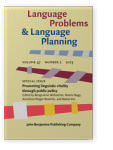Standardization and vitality
The role of linguistic purism in preventing extinction
This paper examines the relation between linguistic purism, standardization, and vitality, arguing that linguistic
purism warrants renewed emphasis as a necessary heuristic for preventing language endangerment and extinction. Linguistic purism
has developed an unfavourable reputation in contemporary linguistics and is frequently portrayed as irrational and reactionary.
This is partly due to its historical association with nationalism, and partly due to the descriptive rather than prescriptive
nature of contemporary linguistics. This paper argues that linguistic purism is actually rooted in progressive rather than
reactionary political thought and activity, and is a constitutive feature of Western Modernity. Moreover, its historical
association with nationalism is more accurately understood as anti-colonial resistance, a grassroots version of which can be
observed across numerous non-Han ethnic groups in the People’s Republic of China today. Using the explanatory framework of linguistic relativity, the
paper further argues that purism is a rational rather than reactionary response to excessive
translingual borrowing.
Article outline
- 1.Introduction
- 2.Linguistic purism: Conflicting approaches and caricatured characterizations
- 3.Purism and standardization: A reactionary synthesis or pillar of western modernity?
- 4.Language as a carrier of culture: Renaissance precursors
- 5.Linguistic relativity
- 6.Linguistic purism as anti-colonial resistance
- 7.Conclusion
- Acknowledgements
- Notes
-
References
